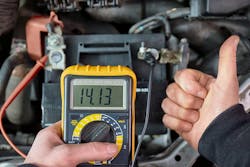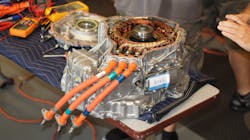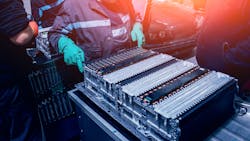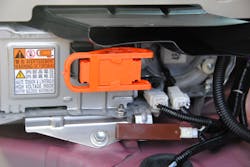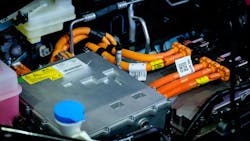What you will learn:
• In Canada, all light duty vehicles must be zero-emission by 2035
• Hybrid and EVs are no more challenging to diagnose than vehicles equipped with an ICE; just different
• Proper training, common sense and the correct PPE will keep technicians safe
This announcement isn't unique, only the most recent. Thirteen states representing over one-third of total new car sales in the U.S. have also announced ZEV mandates. In addition, many countries, especially in western Europe, have passed even stricter legislation on the internal combustion engine.
Our industry is arguably in the midst of its most significant and broadest-reaching change ever, resulting in unprecedented challenges to everyone associated with the transportation network. As a result, we all have new skills to learn.
This refocus shouldn't be a surprise. Since the early 2000s when the Prius hit the U.S. market, we've all been aware that EVs would become a growing part of the automotive landscape and have had ample time to prepare for their growth, driven by legislation, OEM rollouts, and consumer demand.
So why is it then that we are not only short on qualified EV technicians but also on the availability of talented service personnel overall? By 2005 or 2006, a betting man with the foresight to see the continuing growth of EV sales would have wagered on our ability (as a diagnostic and repair community) to evaluate and prepare for the future. This isn't the case, at least in my neck of the woods.
A personal anecdote
My family has had an electric vehicle in our arsenal since 2007, and our current one is a 2014 plug-in Prius. This car now has almost 200,000 miles and has been surprisingly trouble-free. Other than front suspension work we had completed this year and an electric steering rack a few years back, only standard maintenance like tires, brakes, and sealed lead-acid battery (SLA) replacement have been necessary.
It's good that the vehicle has been so reliable, as our local dealership has constantly struggled with supplying good quality and consistent service for our hybrid vehicles. Their service and repair personnel are great folks and try hard to meet our needs, but it seems like they have a revolving door of "the guy" who works on hybrids. Sometimes their tech appears to know their stuff, other times, not really. This lack of consistent personnel can't be from lack of work, as we live in a college town, and hybrids are almost as prevalent as the popular go-to-school vehicle, the Jeep Wrangler.
However, late last year, we found an independent shop that doesn't have a trained electric vehicle tech, but they're willing to learn. They see an opportunity to grow their business and are eager to invest the time and money in training and the tools needed to service EVs. Again, we've been lucky that we've had no significant issues, but inevitably one will surface, and I have some hope that we will have a local shop to meet our needs.
So, what's the answer? So far, the repair community has been pretty good at playing ostrich by burying our heads, but that will soon no longer be an option. EV sales are growing, the vehicles are going out of warranty, and the need for OEM and independent technicians to correctly diagnose and repair EVs is becoming more paramount.
Training and skills development
Unlike other automotive disciplines, the importance of EV technician training is crucial for customer satisfaction and, more importantly, the safety standpoint. Electric and hybrid-electric vehicles are no more challenging to diagnose and repair than internal combustion engine-powered vehicles, just different. Technicians who think they can just "wing it" are placing themselves and the client (entrusting them to correctly repair their vehicle) in a dangerous position by not understanding EV design and operation basics.
There are many options for affordable technician training on electric vehicle repair, but before investing dollars in it, ask yourself if you have a sufficient understanding of electrical theory. Having a digital multimeter is a start but knowing how to use it is even smarter. Do you truly understand circuits, voltage, resistance, and current? What about Ohm's law, voltage drops, series, and parallel circuits? Do you know how to use your meter, the correct leads for each situation, or how to make sure the fuse isn't blown?
Surprisingly, according to many industry folks with way more experience and knowledge than I'll ever have, the lack of understanding of basic fundamental electrical skills and correct meter usage is one of the largest challenges we face. Unfortunately, many experienced mechanics have just "gotten by" with knowledge gleaned on the job and sometimes struggle because of their lack of formal training.
There are many options out there for EV training, but not as many for foundational electrical skills. An alternative I've become familiar with is with ATech Training out of Kentucky. They have a newly designed system for the shop owner, supplying equipment and courseware to teach foundational electric skills on the job at your own pace. This isn't an endorsement of this product, but it is the one that allows a shop owner to train their techs on-site when they have some free time. Even if you aren't interested in moving into the EV field, truly understanding electrical diagnostics is well worth the effort for almost every vehicle that comes through your door.
For continuity, let's assume that your shop is up to speed on electrical diagnostics, can set up and use its meters effectively, and has assured its meters are fully functional. How do we move into EV repair? Let's outline what a good electric vehicle course will teach you.
Safety
Before that first Nissan Leaf or Chevrolet Bolt crosses your doorstep, proper safety equipment, tools, and personal protective equipment must be purchased. Items such as high-voltage gloves, insulated hand tools, suitable high voltage meters and leads, and other various items are a good start. What you may not know that is almost as important as the tools is a researched and documented standard operating procedure for electric vehicles.
Remember when we spoke about how these cars are different? Well, their inclusion in your repair flow should be different too. Although some EVs are easily recognizable by their body lines or badging, many aren't as quickly identifiable at a glance. Prius on the shop floor? Pretty much everyone will recognize it for what it is. How about a new Ford F150 Lightning or the upcoming Chevrolet Electric Silverado? I'll bet at a glance you would just assume they're just an ICE (internal combustion engine)-driven vehicle that you've worked on hundreds of times before. Identifying the car in the shop can be as important as having the correct tools and training to work on it.
I like the idea of labeling an EV as soon as it enters the facility with a bright tag that says "EV" under the wiper. Having your service department make this a standard part of the vehicle acceptance process can help make sure these vehicles with new diagnostic challenges are identified quickly and accurately by everyone in your shop. Other items to be added to your "SOP" should be orange traffic cones.
Although I've never been an employed technician, I grew up around several shops. My father was a career parts manager for various GM, Jeep, Mitsubishi, Chevrolet, and other OEM brands, and I've witnessed first-hand the hijinks that can occur between employees. It's all in good fun, and everyone enjoys a good laugh but giving someone a good goose on the backside while he's elbow deep in 800V is something we all need to avoid. Marking the area where an EV is under active diagnosis with a few cones can help move that wet willie you owe “Benny” to a safer time and place.
Types of EVs
Yeah, there are different flavors. Just like you now work on 4, 6, and an ever-decreasing number of 8-cylinder engines, EVs have different flavors. The three most significant are battery-electric, hybrid-electric, and plug-in hybrid-electric.
Battery-electric vehicles (or BEVs) operate solely on battery power. A drivetrain generally consists of at least one electric motor, a high-voltage battery, and components that control and operate the other vehicle components. These vehicles have unique systems compared to cars with an ICE, as BEVs have no accessory belt to drive systems such as power steering pumps and AC compressors, and these components need to have their source of power to operate. Examples of BEVs would be the Nissan Leaf, Chevrolet's Bolt, and the entire Tesla line of vehicles.
Hybrid-electric vehicles (referred to as HEVs) are the most prevalent vehicle on our highways as they do not require to be plugged in to be charged. HEVs have both electric and gasoline motors. The high voltage battery is charged by capturing torque from the gasoline motor and capturing kinetic energy from braking and drifting of the vehicle. A great example of an HEV is the Toyota Prius.
The last category is the plug-in hybrid electric vehicle (or PHEV). You've probably already guessed what this vehicle is — an HEV that also allows you to plug in to charge the battery. For example, my wife's vehicle is a Prius PHEV, so she can drive it simply as a hybrid and not plug it in, or if she wishes and has access to a vehicle charging station, she can bring the battery up to full capacity.
You may have heard of a fourth category, the fuel cell electric vehicle (FCEV). Fuel cell vehicles are available in a few states and operate like a BEV; only they create electricity through a chemical process utilizing high-pressure onboard stored hydrogen. The development of this technology is still ongoing. It may become a major player in the future, but for now, there are only a few out there that are only sold or leased through dealerships that have passed significant training to support them.
As mentioned above, EVs have some unique components that training will make you familiar with. High voltage batteries, electric motor/generators, planetary gearsets that link ICE and EV motors, and ancillary components like electric steering racks, electric A/C compressors, electricity inverters, and converters.
Disabling and isolating
Each EV has similar components but also a unique controlling infrastructure on how they operate. Before beginning any repair work on the HV system, the vehicle will need to be disabled so that the car cannot operate and isolate the high voltage to one location – the battery.
The way EVs are constructed makes it difficult to remove the HV battery or totally discharge the power it possesses. Standard industry practice is to remove what is called the vehicle's high voltage service plug. Present in all mainstream vehicles with a high voltage battery, the high voltage service plug is a gateway between the high voltage battery and the rest of the vehicle's systems. Removing it allows the technician to isolate all high voltage to the battery and renders the vehicle inoperative.
What else should I know?
A good EV technician class will cover the above and a whole lot more. Here is a list of things you should seek out when looking for training:
- Safety and personal protective equipment
- How to operate EVs
- Electric powertrains
- EV diagnostic information and procedures
- High-voltage battery packs
- High-voltage relays and charging systems
- Inverters/converters
- Motor/generators
- Component removal and replacement
- Electric vehicle maintenance
- EV 12V systems
- ICE and the hybrid vehicle
A final thought
Internal combustion vehicles are going to be here for a long time. Analysts predict they will be produced and sold for years to come; and with modern vehicles' lifespan (easily reaching the 250,000-mile range), there will be a need for their maintenance and repair far into the future. This also doesn't account for ICE vehicles' medium and heavy duty categories or the enthusiast market. The skills that repair techs hold today are valuable and will continue to be critical for our vehicle infrastructure. However, in taking a realistic look at the direction that the light-duty vehicle market is moving, it is plain to see that the need for electric vehicle repair support is going to be a growth industry, and today's automotive shop and technician needs to begin planning now to be a part of that growth.
These vehicles are no more difficult or dangerous to support than the ICE vehicles we work on now; they're just different. Many of their systems and components are the same, and you will find that many of the skills and tools you currently possess will apply to them. I encourage you to seek training now to take advantage of this market and be best prepared for the future because it is a strong possibility your competitors will.
About the Author
Micheal Smyth
Micheal Smyth is a founding partner and Director of Training for AFV Educate, a not-for-profit 401(c)(3) training organization specializing in alternative fuel curriculum development and educational presentation for first and second responders and automotive technicians. His previous positions included Director of West Virginia University’s National Alternative Fuels Training Consortium and Director of Training at Automotive Video Innovations. Mike has over 12 years of experience working with and presenting information on AFVs. Connect with him at LinkedIn.


